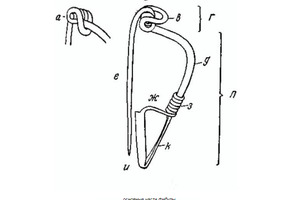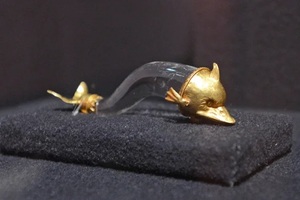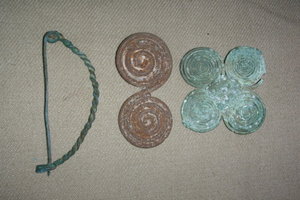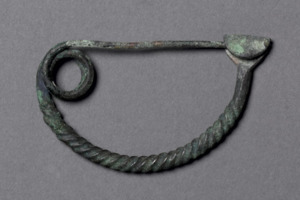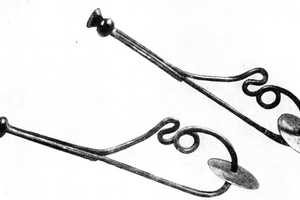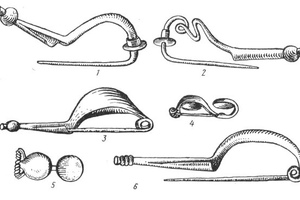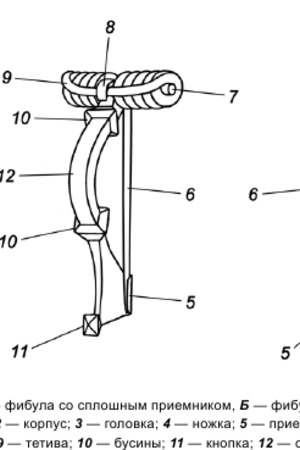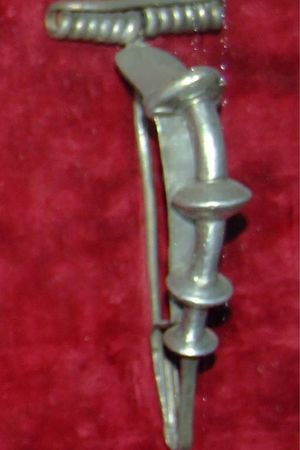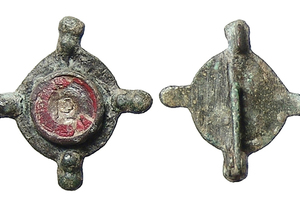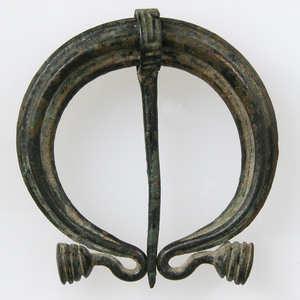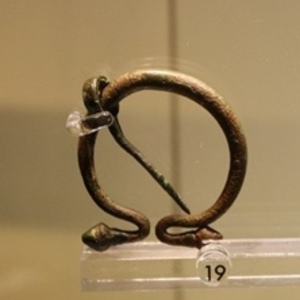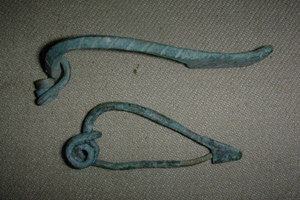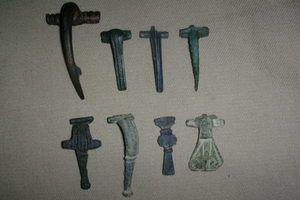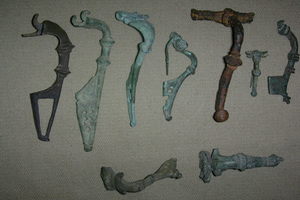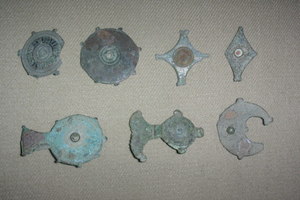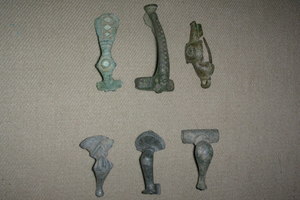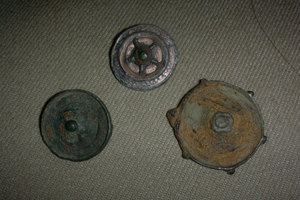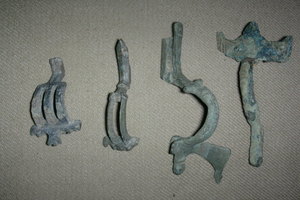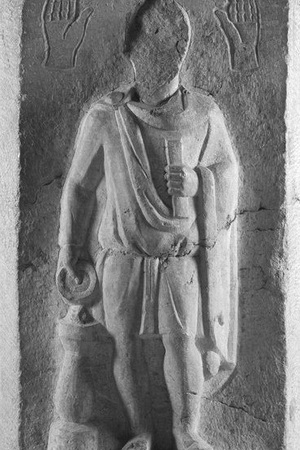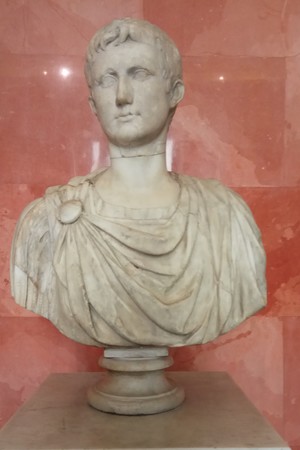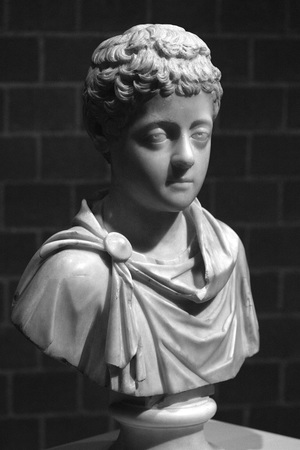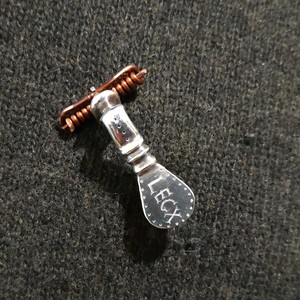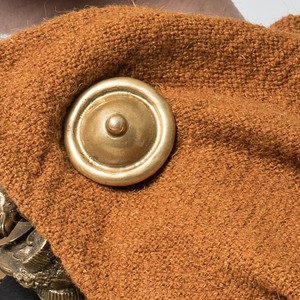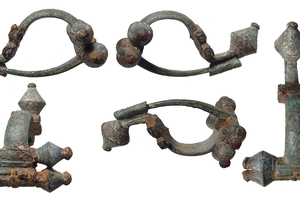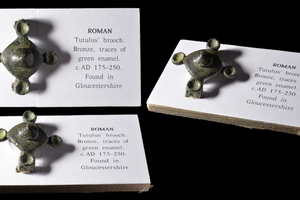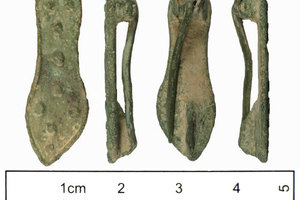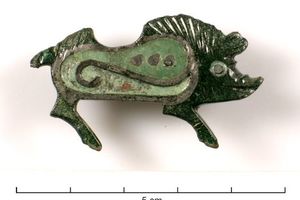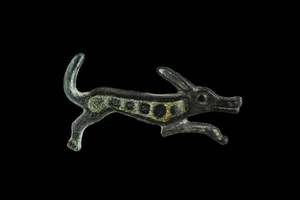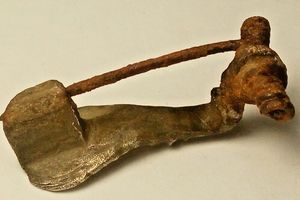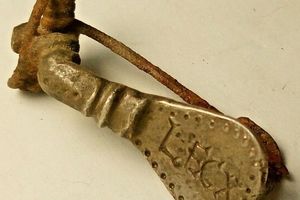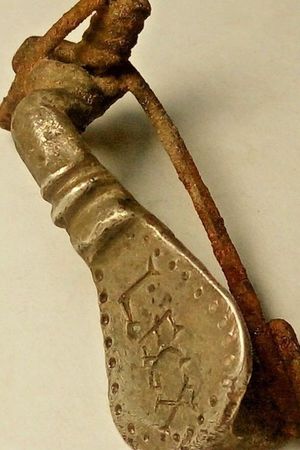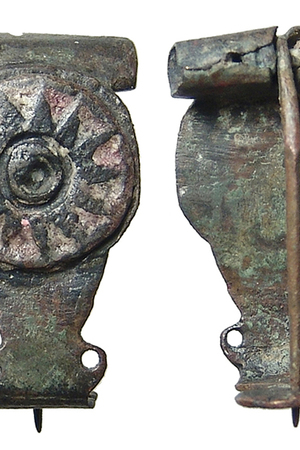Fibula
A fibula (Latin: fibula, meaning "clasp") is an ancient type of metal garment fastener that could also serve as an ornament.
Fibulae of various shapes and sizes were widely used from the Iron Age to the Middle Ages, eventually being replaced by buttons.
Structure of a Fibula
Most found fibulae are made of bronze, but there are also examples made of silver, iron, gold, or their alloys. There are composite fibulae, where different structural elements are made of different materials. Many of the discovered specimens are decorated with artistic patterns, engravings, enamel, semi-precious stones, glass, coral, or bone.
Fibulae often had a complex structure. Currently, the following components are distinguished:
- Pin
- Bow (or body)
- Catchplate (pin holder, preventing the fibula from unfastening and the skin from scratching)
- Spring, connecting the pin to the bow
In addition to fibulae, there were also simple pins or needles, sometimes ending with a metal ball, often richly adorned.
At the end of the 1st century BCE or the beginning of the 1st century CE, a new subtype of fibula appeared. They had a separate pin attached to the head part of the body with a small hinge. In the second half of the 1st century CE, loops were introduced in plate fibulae. One or two small plates were cast on the back of the plate, and the pin was attached to them with a small hinge. Earlier plate fibulae had bilateral springs attached to the back. In the 3rd century CE, the hinge was placed in the center of a long transverse bar, creating the well-known type of fibula.
History
The first fibulae, shaped like a violin bow, appeared at the end of the Bronze Age. This simple construction with a unidirectional spring is similar to modern pins. The violin bow fibula had a low, flat bow. The body ran parallel to the pin and could be round, square, or have more complex cross-sectional shapes. Some fibulae found had small ornaments at their ends.
One of the first fibulae in the shape of a violin bow was found in Mycenae in the Greek Peloponnese in the 14th century BCE (Peschiera and Unter-Radl types). In Greek culture, it is believed that Mycenae was the center of fibula distribution, from where they spread to trading points in Crete, Cyprus, and Sicily.
The second type of fibula has a high, rounded bow instead of the low, flat bow of the violin bow fibula. In earlier finds, the bow was relatively thin, while in later variants, its thickness increased, being made of thicker metal or two thin wires twisted together. These round fibulae were first discovered in the 12th century BCE and remained in use for more than five centuries.
The third type of fibula consisted of horizontal wire spirals. The fibula consisted of two spirals connected together. Examples of such fibulae are Haslau and St. Lucija, which were found in the 9th-7th centuries BCE. Later, in the 6th century BCE, fibulae with four small spirals and a square plate in the middle, called Vierpass, appeared.
Italian fibulae exhibit a wide variety in terms of the pin holder structure and bow shape. In the oldest Italian fibulae, as well as in later Hungarian and Scandinavian ones, the pin holder is formed by several turns of a spiral. In subsequent modifications, the spiral pin holder is replaced by a round, flat plate, and later by a plate with bent edges, forming a catchplate, sometimes ending with a button.
In terms of bow shape, Italian fibulae can be categorized as follows:
Bow-shaped: These fibulae have a bow in the shape of a semicircle. This is the type of the oldest fibulae. The bow can be of uniform thickness or thickened at one or several points. It can be completely smooth or decorated with longitudinal and transverse lines, beads, etc.
Serpentine: This is the most diverse group of Italian fibulae. The bow is sometimes intricately curved. The pin holder is a long groove, which in later forms ends with a button.
Galstatt fibulae (also known as Chertsey fibulae) are specimens with an elongated bow that smoothly transitions into a grooved pin holder with a button and a turned-up end. Fibulae of this type were found in large numbers in the Chertsey cemetery, among other Italian-type fibulae. This form, consisting of two connected spiral loops, is very similar to Hungarian, Scandinavian, and especially Greek fibulae.
In addition to various Italian fibula forms, Galstatt burials have also yielded fibulae that are characteristic only of the Galstatt region. Among them, particularly interesting are the eye-shaped and crossbow-shaped fibulae (fibules à l'arbalète).
Crossbow-shaped fibulae are characterized by a spring that consists of a series of spiral turns perpendicular to the bow. In some crossbow-shaped fibulae, the end of the pin holder is adorned with a head of a human or animal, bent upwards and slightly backwards. These fibulae, along with the fibulae from the Chertsey burial, represent a transition to the La Tène type fibulae, which are characterized by a sharply bent backward end of the pin holder.
Brooch fibulae (also known as "shield-shaped" fibulae): In brooch fibulae, a mandatory structural element is the shield. The shield serves as a decorative element and is often adorned with images (made through stamping or casting). The shield could also be inlaid with precious metals or precious and semi-precious stones.
Omega-shaped fibulae are characterized by their resemblance to the Greek letter omega, from which they derived their name. The pin in omega-shaped fibulae can be diagonally placed from one part of the body to the other or positioned straight from top to bottom. Fibulae of this type were used by both Romans and Greeks.
In the Iron Age, fibulae were widely used.
The rapid expansion of the Roman Empire by the 1st century AD led to a significant increase in the number of fibulae of various types throughout Europe and the Middle East. The spread of technologically advanced workshops within the Roman Empire resulted in more complex fibula constructions. The bows were cast in more intricate forms, and loops appeared alongside double-spring mechanisms.
One of the earliest known types of Roman fibulae appeared in the late 1st century BC. The straight pin fibula, also known as the soldier or legionary type fibula, is a very simple design. It resembles the earlier bow fibula that existed over a thousand years earlier, with the only difference being a slightly steeper bow and a double-spring mechanism.
In the 1st century AD, several types of fibulae appeared in Roman Britain, among which the most interesting type was the "Dolphin" fibula. Dolphin-shaped fibulae feature a smooth arched bow that tapers from the head to the end. The long double-sided spring is hidden. From the top, the fibula resembles a "T" or a late Roman crossbow fibula, while from the side, it resembles a leaping dolphin.
Another type of British fibula was the so-called "Hod Hill" fibula. Usually, these Hod Hill fibulae are quite small and have a small arched bend, which seems to consist of segments. Many Hod Hill fibulae have a pair of small lateral protrusions.
There is also a third type of British fibula sometimes identified as the "Thracian anchor" type. They have a wide crescent shape on the body, giving the fibula the appearance of an anchor. The Thracian anchor type is also referred to as Illyrian and can be found in Pannonia (Hungary), Dacia (Romania), and Serbia.
The knee-shaped fibula, which was widespread in the 2nd century AD, originated in Roman Pannonia (modern-day Hungary). Archaeologists believe that its 90-degree curved bow resembles a knee and leg. Many knee-shaped fibulae have semi-circular heads of various sizes. It appears that knee-shaped fibulae, like Augen-type fibulae, spread throughout the Roman Empire thanks to Germanic allies. Despite their small size, their presence in Roman military graves indicates that this type of fibula was popular among Roman soldiers in the 2nd century AD. They are rarely found outside military contexts.
The "R-shaped" type is another common form of fibula from the 2nd century AD, originating from Germanic peoples. The R-shaped fibula, or the Almgren type, has a semi-circular bow and a long pin that bends back underneath itself to return to the base of the bow. They have double-sided springs. The bows of R-shaped fibulae are usually semi-circular and decorated with ribbed patterns in cross-section. R-shaped fibulae are dated from the 2nd to the early 4th centuries AD.
The use of shield-shaped fibulae continued into the 2nd century AD. Simple flat forms were replaced by enameled versions or more complex shapes. These included animal (zoomorphic) figures (birds, horses, rabbits, flies, etc.), letters or words, abstract symmetric or asymmetric patterns (including Celtic spirals), and skeuomorphic patterns (symbolic designs). Most of the previous types of fibulae continued to be worn during the 2nd and 3rd centuries.
Usage
In the Roman Empire, fibulae were used by everyone: men, women, children, soldiers, officers, and even emperors couldn't do without them. The male population typically used fibulae for cloaks: penulae or sagums. They could also be used for tunics and focal points. Since fibulae were usually displayed prominently and often highly adorned, it is logical to assume that they can be considered as ancient jewelry rather than just a functional garment element.
Other cultures also used fibulae, particularly the Celts and Greeks.
Women fastened their cloaks or other types of outer garments with fibulae. They could also fasten fabrics symmetrically using multiple fibulae on both sides.
 Bust of the Goddess, 2nd century AD, The Princeton University Art Museum
Bust of the Goddess, 2nd century AD, The Princeton University Art Museum
Reenactment
The main period of reconstruction for our club is the mid-1st century to the early 2nd century (50-125 AD). However, it is known that fashion trends in jewelry changed much more slowly, and particularly colorful specimens could be passed down through generations. They were not strictly limited to specific periods or locations of use. Therefore, fibulae from a slightly broader period (within reason) can be used.
It should also be noted that apart from military fibulae with legionary symbols, there were no strict restrictions on the use of fibulae based on social status.
They are recommended to be made of brass or silver. Brass can be used to simulate gold and silver to reduce the cost of reconstruction.
Related topics
Penula, Sagum, Focale, Tunic, Legionnaire, Auxiliaries, Legion
Literature
Yarwood, Doreen (1986). The Encyclopedia of World Costume. Bonanza Books. ISBN 0-517-61943-1
Voronov, Yu. N., Caucasian arc-shaped fibulae of the Early Iron Age, KSIIMK, Moscow, 1983, no. 176, pp. 29-33.
Fibulae // Encyclopedia of Brockhaus and Efron : in 86 volumes (82 volumes and 4 additions). - St. Petersburg, 1890-1907.

 Gallery
Gallery






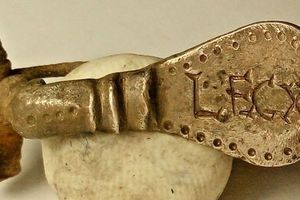 Fibula of the Tenth Legion. Silver. Private collection. Length-31mm, width-11mm, weight-5g. Second half of the 1st century BC.
Fibula of the Tenth Legion. Silver. Private collection. Length-31mm, width-11mm, weight-5g. Second half of the 1st century BC.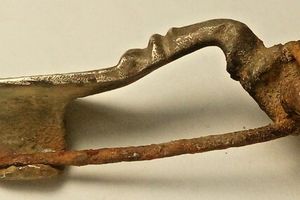 Fibula of the Tenth Legion. Silver. Private collection. Length-31mm, width-11mm, weight-5g. Second half of the 1st century BC.
Fibula of the Tenth Legion. Silver. Private collection. Length-31mm, width-11mm, weight-5g. Second half of the 1st century BC.